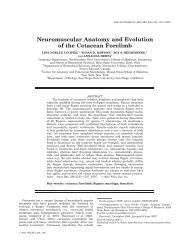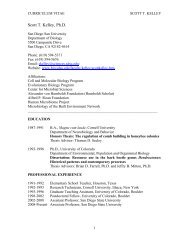Comparative anatomy and evolution of the odontocete forelimb
Comparative anatomy and evolution of the odontocete forelimb
Comparative anatomy and evolution of the odontocete forelimb
You also want an ePaper? Increase the reach of your titles
YUMPU automatically turns print PDFs into web optimized ePapers that Google loves.
16 MARINE MAMMAL SCIENCE, VOL. **, NO. **, 2009<br />
Figure 7. Plot <strong>of</strong> contrasts found between body length <strong>and</strong> flipper area, showing correlation<br />
found.<br />
<strong>and</strong> <strong>the</strong> stiffening <strong>of</strong> <strong>the</strong> manus, <strong>the</strong>re were a series <strong>of</strong> changes that adapted <strong>the</strong><br />
<strong>odontocete</strong> flipper for hydrodynamic efficiency. These changes include osteological<br />
transformations that vary within <strong>and</strong> among <strong>the</strong> different <strong>odontocete</strong> families, as<br />
well as differences in muscle architecture, <strong>the</strong> amount <strong>and</strong> organization <strong>of</strong> s<strong>of</strong>t tissue<br />
encasing <strong>the</strong> flipper, <strong>and</strong> <strong>the</strong> development <strong>of</strong> various flipper shapes.<br />
This is <strong>the</strong> first study to examine <strong>odontocete</strong> <strong>forelimb</strong> <strong>anatomy</strong> in a comparative<br />
<strong>evolution</strong>ary context. A detailed description <strong>of</strong> <strong>the</strong> architecture <strong>of</strong> bones <strong>and</strong> muscles<br />
found in <strong>the</strong> <strong>odontocete</strong> flipper among several species is provided. Many <strong>odontocete</strong><br />
species have modified <strong>the</strong> skeletal elements <strong>of</strong> <strong>the</strong>ir <strong>forelimb</strong> by developing different<br />
shapes, such as that seen in <strong>the</strong> olecranon process <strong>of</strong> <strong>the</strong> ulna. Expansion or reduction<br />
<strong>of</strong> skeletal elements is also observed, such as in <strong>the</strong> acromion <strong>and</strong> coracoid process <strong>of</strong><br />
<strong>the</strong> scapula. The development <strong>of</strong> longer or extra bones to elongate <strong>the</strong> flipper, <strong>and</strong><br />
<strong>the</strong> development <strong>of</strong> varying amounts <strong>of</strong> connective tissue, allowed for <strong>the</strong> <strong>evolution</strong><br />
<strong>of</strong> different flipper morphologies.<br />
This study suggests that muscles with thicker muscle bellies <strong>and</strong> greater degree <strong>of</strong><br />
muscle differentiation, provide better control. Thus, a deltoid muscle with a thicker<br />
muscle belly <strong>and</strong> larger muscle fascicles allows for stronger extension <strong>and</strong> abduction<br />
<strong>of</strong> <strong>the</strong> humerus. The differentiation <strong>of</strong> <strong>the</strong> subscapularis muscle into several fairly<br />
independent columns allows for better movement control.<br />
There is a clear relationship between muscle <strong>and</strong> bone indicating that as muscles<br />
become larger, bones also increase in size (Daly et al. 2004). Thus, <strong>the</strong> widening <strong>of</strong><br />
<strong>the</strong> scapula possibly allowed for greater development <strong>of</strong> <strong>the</strong> subscapularis muscle due<br />
to a broader site for muscle attachment. Along with <strong>the</strong> stiffening <strong>of</strong> articulations<br />
within <strong>the</strong> manus (Sedmera et al. 1997, Cooper et al. 2007a), this study suggests<br />
that <strong>the</strong> increase in muscle mass also allowed for development <strong>of</strong> a stronger flipper




